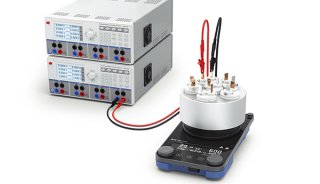Isolation, Culture, and Differentiation of Progenitor Cells-2
Slide Coating
13. Just before use, dilute the poly-D-lysine stock solution 1:50 in H2O. Add 0.2 mL of diluted poly-D-lysine to each well of an eight-well chamber slide. Incubate for 1 h at room temperature.
14. Wash wells three times with H2O. Add 0.2 mL of diluted laminin to each well and incubate overnight at 4°C.
Store slides at 4°C until use and wrap in parafilm to minimize evaporation.15. Before use, remove laminin and wash wells once with Neurobasal medium (PSG).
Do not remove the laminin from the wells until immediately before use.
Differentiation
16. Add 100 µL of NEP complete medium to each well of a poly-D-lysine/laminin-coated eight-well chamber slide (prepared as described in Steps 13-15). Transfer one sphere (from Step 12) to each well using a P200 pipette and incubate overnight at 37°C.
17. After 24 h, ensure spheres have attached to the slide (Fig. 3B); then carefully remove medium. Add 200 µL of NEP basal medium containing 2% heat-inactivated horse serum.
18. Culture for 2-3 d, changing medium daily.
19. For fixation and subsequent immunohistochemical analysis (Fig. 3C), remove medium, rinse once with 1X PBS, and fix with 4% PFA in 1X PBS for 1 h at 4°C.
Secondary Neurospheres
20. Using a P20 or P200 pipette, mechanically dissociate a single neurosphere in a 1.5-mL microcentrifuge tube.
If this is difficult, incubate spheres in trypsin for 5 min and dissociate mechanically.21. Centrifuge the cells at 3000 rpm for 5 min and resuspend in NEP complete medium.
Plate cells individually in 96-well, low cell binding plates or bulk passage multiple spheres asdescribed in Step 10.
DISCUSSION
The development of a cell culture system designed to isolate and propagate putative stem cells from neural tissue (Reynolds and Weiss 1992; Reynolds et al. 1992) has greatly advanced ourunderstanding of these cell populations. This technique has not only provided a means to monitor the physical characteristics of these cells, but has also enhanced our ability to manipulate the genetic and epigenetic factors that regulate both their capacity to self-renew and to differentiate into the three defined cell types of the nervous system: neurons, astrocytes, and oligodendrocytes. In the presence of epidermal growth factor (EGF) and/or basic fibroblast growth factor (bFGF), these cell populations can be reliably expanded and maintained in the form of neurospheres and, upon removal of these growth factors, can efficiently generate the three major CNS cell types.
Advances in mouse genetic manipulation, as well as the development of more powerful analytical technologies (e.g., FACS), have resulted in the development of multiple modified protocols of the neurosphere assay. For instance, the utilization of mouse lines containing multiple targeted mutations typically generates only a small fraction of animals carrying the desired genotype. Given that the total percentage of neural stem cells can be quite small (<0.1% in adults [Reynolds and Weiss 1992]), it is often important to maximize the yield of neural stem cells from these animals. We have found that the often-used trypsin-basedenzymatic dissociation can be deleterious to cells, resulting in a high percentage of cell death after isolation. Here we provide an alternative protocol utilizing the enzyme papain, which, in our hands, is more efficient and less destructive in dissociating neural tissue, and therefore provides a greater yield of viable stem cells. It should be noted, however, that we have found that culture conditions, including enzymatic incubation times and plating densities, vary between age points as well as different neural stem cell populations, and therefore may need to be determined on an individual basis.
Although historically utilized as a means to retrospectively identify neural progenitors, today the NSA can be used in the prospective isolation and propagation of neural progenitors. The generation of mouse strains expressing fluorescent proteins under the control of neural progenitor specific markers (Nestin-EGFP [Kawaguchi et al. 2001], Sox2-EGFP [Ellis et al. 2004], and hGFAP-EGFP [Zhuo et al. 1997]), coupled with the ability to efficiently isolate these cell types using FACS, has allowed the culture of highly enriched populations of neural progenitor cells, and, using the NSA, examination of the proliferative, self-renewal, and multipotential capacities of these cells in vitro.
REFERENCES
Ellis P., Fagan B.M., Magness S.T., Hutton S., Taranova O., Hayashi S., McMahon A., Rao M., Pevny L. 2004. SOX2, a persistent marker for multipotential neural stem cells derived from embryonic stem cells, the embryo or the adult. Dev. Neurosci 26: 148–165.[Medline]
Kawaguchi A., Miyata T., Sawamoto K., Takashita N., Murayama A., Akamatsu W., Ogawa M., Tano Y., Goldman S.A., Okano H. 2001. Nestin-EGFP transgenic mice: Visualization of the self-renewal and multipotency of CNS stem cells. Mol. Cell Neurosci 17: 259–273.[Medline]
Polleux F., Ghosh A. 2002. The slice overlay assay: A versatile tool to study the influence of extracellular signals on neuronal development. Sci. STKE 136: PL9. doi: 10.1126/stke.2002.136.pl9.
Reynolds B.A., Weiss S. 1992. Generation of neurons and astrocytes from isolated cells of the adult mammalian central nervous system. Science 255: 1707–1710.[Abstract/Free Full Text]
Reynolds B.A., Tetzlaff W., Weiss S. 1992. A multipotent EGF-responsive striatal embryonic progenitor cell produces neurons and astrocytes. J. Neurosci 12: 4565–4574.[Abstract]
Zhuo L., Sun B., Zhang C.L., Fine A., Chiu S.Y., Messing A. 1997. Live astrocytes visualized by green fluorescent protein in transgenic mice. Dev. Biol 187: 36–42.[Medline]




















